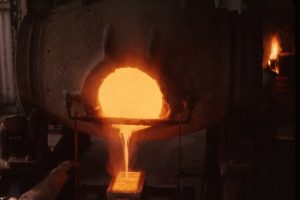What is the Melting Point of Gold?
14/03/2021Daniel Fisher
Free & fully insured UK Delivery. Learn more
Secure & flexible payments. Learn more

Buyback Guarantee Learn more
As a precious metal, gold has very little competition. Its amazing chemical properties make it invaluable in the industry. Gold is used to manufacture jewellery, as a conductor in electronic components and even pulled out into wires. More importantly, gold is purchased by investors as coins and bars. Due to its price stability, investors often convert their money into gold during times of economic crisis. Investment-grade gold will normally be 22 carats or higher, with a fineness of 99.9%. All investment-grade gold bought in the UK is VAT exempt and CGT (Capital Gains Tax) exempt up to a limit.
However, when gold is used in industry, it needs to be melted down, according to the requirements of certain applications. Gold is often melted and then merged with other base metals like copper to achieve a certain level of hardness. Since gold is a soft metal, jewellery and other items cannot be formed when the metal is in its purest form. Gold is also alloyed with certain metals to obtain specific colours, which are popular amongst customers. The formation of gold bars also requires the metal to be melted and poured into casts.

Gold is converted to its liquid state at a temperature of 1064 Celsius
Gold changes its form, i.e. melts from its solid-state into a liquid at 1064°C. Its boiling point can also be obtained at 2856°C. As we can see, these are extremely high temperatures and the gold melting point is usually achieved in specialised industrial facilities. If other metals are already present in the gold, then the temperature required to achieve the melting point of gold will vary. Therefore, 18-carat or 14-carat gold will typically contain a larger percentage of other base metals, causing a variance in the melting point of gold.
As discussed above, this industrial process usually requires a furnace to apply the heat in order to execute the process efficiently. The extremely high temperature at which the gold melting point is reached can be generated by a high power furnace. It is important to understand the difference between the words ‘melting point of gold’ and smelting. The process of melting simply converts the metal into a liquid state. In this case, the chemical qualities of the metal remain unchanged. There is simply a change of state. Smelting, on the other hand, is a different process in which impurities contained within the gold are burned off. Therefore, the temperature required to do this may vary from the gold melting point. Once these impurities have been burnt off, the remainder in most cases is almost pure gold.

A furnace is usually required for the commercial melting of gold
The process of melting gold has been around for thousands of years, long before the invention of high-powered furnaces. How did we melt gold through these years? Well, did you know that the ancient Egyptians used a combination of charcoal along with blowpipes to hit the gold melting point? They were also able to remove impurities from the gold by using this process. For jewellery craftsmen or individuals who want to melt their own gold at home, or operate a small-scale industry, there are propane-powered gold melting kilns available today. Flux can be used in these devices to extract impurities. However, only small amounts of gold can be processed by using these kits.
At Physical Gold, our experts are happy to help you with queries related to precious metals. We can also advise you on making the best purchases when it comes to gold or silver. Please call us on (020) 7060 9992, or get in touch with us online by visiting our website. We are always happy to help.
Image credits: andressolo and PxHere
Live Gold Spot Price in Sterling. Gold is one of the densest of all metals. It is a good conductor of heat and electricity. It is also soft and the most malleable and ductile of the elements; an ounce (31.1 grams; gold is weighed in troy ounces) can be beaten out to 187 square feet (about 17 square metres) in extremely thin sheets called gold leaf.
Live Silver Spot Price in Sterling. Silver (Ag), chemical element, a white lustrous metal valued for its decorative beauty and electrical conductivity. Silver is located in Group 11 (Ib) and Period 5 of the periodic table, between copper (Period 4) and gold (Period 6), and its physical and chemical properties are intermediate between those two metals.